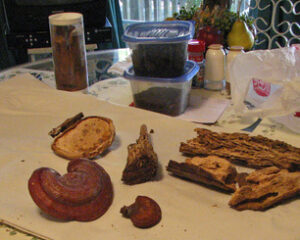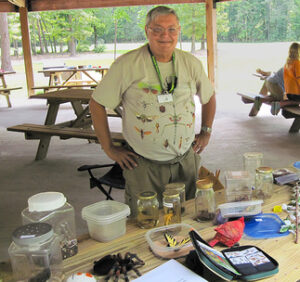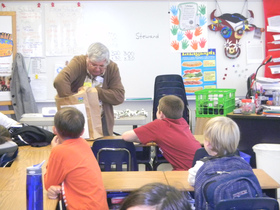Laurels – Fall 2014
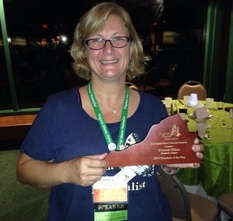 Elisabeth Wilkins (Peninsula Chapter) receives the 2014 Volunteer of the Year Award from the Virginia Master Naturalist program.
Elisabeth Wilkins (Peninsula Chapter) receives the 2014 Volunteer of the Year Award from the Virginia Master Naturalist program.
The 2014 Statewide Volunteer Conference and Training, held September 26-28 at the Virginia Living Museum in Newport News, offered the opportunity to recognize several Virginia Master Naturalist individuals and chapters for the contributions they make to the VMN program and to Virginia’s natural resources. Based on nominations from program volunteers and partners, we recognized the following individuals:
Jim McGlone (Fairfax Chapter) – Chapter Advisor of the Year. Jim is the Urban Forest Conservationist with the Virginia Department of Forestry and the advisor to the VMN Fairfax Chapter (based in Fairfax County) since it began in 2007. His chapter states: “Jim’s relationships developed in the Fairfax County community are numerous, giving us a wealth of resources to draw experts from to support our training courses. Jim’s wisdom and knowledge are invaluable to us as board members.”
Town of Washington Nature Trail and Habitat Restoration Area – Project of the Year. This project, led by the VMN Old Rag Chapter (based in Madison, Rappahannock, Culpeper, Orange, and Fauquier counties) was originally intended to convert an unused piece of land into butterfly habitat, but the project has expanded into a walking trail, numerous native plant gardens, a rain garden, a bluebird trail, and a preserved wetland habitat. The area has received official designation from the Virginia Department of Game and Inland Fisheries as a Certified Wildlife Habitat Area. Work continues to expand the project to a much larger and comprehensive learning venue. In addition to more than 18 VMN volunteers, the project has also involved high school student interns and Virginia Native Plant Society members.
Elisabeth Wilkins (Peninsula Chapter) – Volunteer of the Year. Elisabeth is recognized as a mainstay of VMN’s Peninsula Chapter (based in Newport News and Hampton). While serving in leadership roles, she has doubled committee memberships and tripled chapter participation in continuing education and volunteer service. She has been key to bluebird project development at a local farm and park, is the organizer of the chapter’s vernal pool project activities, and is now organizing a hawk and owl project. Elisabeth has also worked hard to market the chapter in the community and recruit a diverse group of new members, with much success. One nominator wrote, “She is a thoughtful, caring, and knowledgeable advocate for the environment. Her leadership skills have doubled our membership. Her management skills have produced results for members and nature.”
Two awards were given that were not based on nominations, but instead on the volunteer hours that are reported to the statewide volunteer management system database.
Cheryl Jacobson (Historic Rivers Chapter) was recognized for contributing the most volunteer hours in 2013. She reported 1,377.5 hours on a wide variety of projects, including education, citizen science, and stewardship projects, as well as chapter administration. She has contributed service and data to several bird monitoring projects, Save Our Streams, a local butterfly count, WildlifeMapping, and the Community Collaborative Rain and Hail System. She participated in acorn collection for the Virginia Department of Forestry, beach clean-ups, and trail maintenance at York River State Park. She has contributed to environmental education for youth at York County and James City County public schools, and at the VDOF’s New Kent Forestry Center. On top of all that, Cheryl assists with the Historic Rivers Chapter’s basic training course, attends board and committee meetings, and contributes to the chapter’s newsletter.
The Historic Rivers Chapter (based in York and James City counties) was recognized for having the highest number of volunteer hours per active member for 2013. In 2013, the 85 active chapter members contributed 11,243 volunteer hours, averaging 132 hours per active member! They maintain a suite of volunteer opportunities in education, citizen science, and stewardship, and their members contribute to local, state and national efforts. The chapter also has shown leadership in developing new projects in their community.
This fall, the Virginia Master Naturalist program received two competitive grants to support activities relating to our basic training curriculum. The Urban and Community Forestry grant ($5,000), funded by the USDA Forest Service and the Virginia Department of Forestry, will support the development of curriculum resources relating to urban and suburban systems and provide mini-grants to chapters and volunteers engaged in community forestry projects. A second grant ($20,000) from the Virginia Environmental
Endowment, will support the development of curriculum resources on forests, wetlands, coastal and estuarine, and other aquatic systems. As part of the work of both grants, we will be refining the VMN basic training curriculum objectives on those topics, identifying existing curriculum resources to support them, developing new resources such as readings, presentations, and videos, and tying the curriculum to relevant service projects that VMN volunteers can do. Providing more resources to support basic training was one of the most critical needs identified in the VMN recent needs assessment and strategic plan.
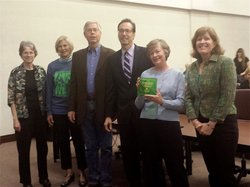 Arlington Chapter members receive the Bill Thomas Award for Volunteer Service from Jay Fisette, Chair of the Arlington County Board.
Arlington Chapter members receive the Bill Thomas Award for Volunteer Service from Jay Fisette, Chair of the Arlington County Board.
Other Laurels
Ida Swenson (Rivanna Chapter) was recognized as the Virginia Cooperative Extension Volunteer of the Month. Ida leads a junior naturalist 4-H club in Fluvanna County, teaches environmental education programs in schools and at events, and has been an instrumental leader for the Rivanna Chapter’s outreach efforts by recruiting and organizing volunteers to teach others about nature at dozens of local events.
Sherry Letnick (Fairfax Chapter) received the Hidden Oaks Acorn Award, given to an outstanding new volunteer of the year, for her service helping with nature programs at Hidden Oaks Nature Center, part of the Fairfax County Park Authority.
Bob Dinse (Fairfax Chapter) received the 2014 Elly Doyle Park Service Award for Excellence in Volunteerism from the Fairfax County Park Authority for his excellent, dedicated work on parkland management and maintenance at Hidden Oaks Nature Center.
The Reconnect With Nature Project (Old Rag Chapter) was awarded the state group volunteer award by the Virginia Health Care Association, an organization of nearly 300 licensed nursing and assisted living facilities in the state. The project, originally launched by VMN volunteer Julie Connelly, brings nature-based educational programs to residents of long-term care facilities. Persons who reside in long-term care communities have limited opportunities to connect with the natural world, yet the connection with nature is fundamental to health, well-being, and the human spirit. Most residents of the long-term care community are dependent on others to experience any aspect of nature. They often require help to go outside, and they may not be offered activities to reconnect them with nature. One question addressed in the Reconnect With Nature project is: How can the natural world be brought home to long-term care? Members of the Old Rag Master Naturalists developed a number of opportunities to bring nature to the residents. The programs include: a resident vegetable garden, a bluebird trail, nature presentations such as slide shows, small groups for Adventures in Nature, a native plants garden, an interactive display of nature trivia.
The Arlington Regional Chapter received the Bill Thomas Award for Volunteer Service, a significant honor in Arlington County that recognizes individuals and groups who demonstrate a “passionate dedication and support” for the county’s natural resources and public open spaces.
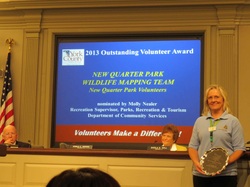 Cherie Aukland (Historic Rivers Chapter) receives the 2013 Volunteer of the Year award from York County on behalf of the Historic Rivers Chapter’s Wildlife Mapping Team.
Cherie Aukland (Historic Rivers Chapter) receives the 2013 Volunteer of the Year award from York County on behalf of the Historic Rivers Chapter’s Wildlife Mapping Team.
The United States Department of the Interior and Colonial National Historical Park presented the George and Helen Hartzog Outstanding Volunteer Service
Award, Group Award, to the Historic Rivers Chapter for assistance in marsh bird monitoring in 2013. Special thanks went out to VMN volunteers Patty Maloney and Dave Youker for their work in the field.
Susan Crockett (Peninsula Chapter) received the Freeman Volunteer of the Year Award for her stewardship work with the Virginia Institute of Marine Science.
The Hampton Roads Alliance for Environmental Education (HRAEE) presented their “Doing Big Things” award to VCE’s Schoolyard Habitats: Monarch Initiative at the annual HRAEE conference, which was held at Jefferson Lab on September 18, 2014. The Schoolyard Habitats: Monarch Initiative is a partnership-driven project that actively involves two state agencies (Virginia Cooperative Extension and the Virginia Department of Game and Inland Fisheries), two public school systems (York County and the City of Poquoson), and members from several local volunteer groups who serve as the crucial outreach partners (York/Poquoson Master Gardeners and Virginia Master Naturalists from the Peninsula and Historic Rivers chapters). These organizations and volunteers have partnered on a dual mission: to reconnect students with nature while positively impacting wildlife conservation.
Several Peninsula Chapter members were recognized by the Virginia Living Museum: Pam Courtney was recognized for 15 years of volunteer service, Brad Halcums was recognized for 3500 hours of volunteer service, Charlotte Boudreau was recognized for 1000 hours of volunteer service, and Larry Lewis recognized for 1500 hours of volunteer service. Larry also received the Energizer Bunny Award for 500 hours of volunteer service within one year.
Jessica Rodgers (Peninsula Chapter) is the new birding columnist for the Daily Press, the daily newspaper for the Peninsula.
Peasley Middle School (life science teacher Sherry Rollins, retired life science teacher Susan Walton) received the Virginia Naturally School Recognition for the 15th year. As Peninsula Master Naturalists they have worked extra hours in the wildlife habitat areas and conducted afterhours activities for students.
Thank you to all the VMN chapters and volunteers who contributed text and photos for this article!
Laurels – Fall 2014 Read Post »


